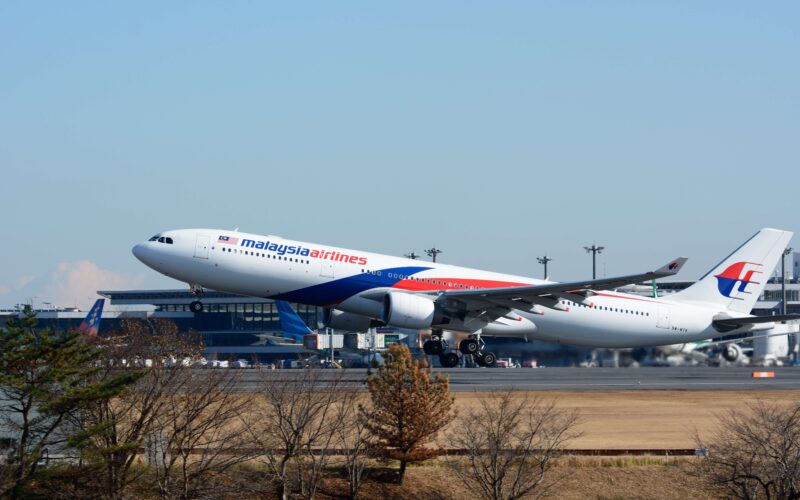The Australian Safety Transport Bureau (ATSB) published a final investigation report into a case of airspeed indication failure during a Malaysia Airlines flight between Brisbane, Australia, and Kuala Lumpur, Malaysia.
According to the Australian transport safety authority, on the night of July 18, 2018, a Malaysia Airlines Airbus A330-300 passenger aircraft, registered 9M-MTK, was expected to operate a scheduled passenger flight from Brisbane (BNE) in Queensland to Kuala Lumpur (KUL), in Malaysia with 14 crew members and 215 passengers on board.
From the early moments of take-off, the instruments showed a red speed flag in place of the airspeed indication. This was followed by unrealistically low airspeeds.
The flight crew did not respond to the speed flags immediately, waiting until the aircraft’s speed was too high to safely reject the take-off, and the take‑off was continued. The report also notes that the flight crew’s initial radio announcement of an urgency situation was not heard by air traffic control.
When the plane climbed to an altitude of 11,000 ft, the pilots performed troubleshooting and other necessary procedures, which led to the shutting down of the aircraft’s air data systems. Then, the flight crew activated the Backup Speed Scale (BUSS), which displayed safe flight envelope information to help the aircraft return to Brisbane and managed to return to the airport of departure.
For technical reasons, the aircraft’s main landing gear doors failed to retract and were slightly damaged during landing.
An inattentive pre-flight walk-around
The ATSB found that several mistakes had been made during ground operations and the pre-flight walk-around before the aircraft departed from Brisbane. Investigators concluded that in accordance with local informal practice, a support engineer placed covers on three of the aircraft’s pitot probes (also known as airspeed sensors). This was done to prevent the equipment from becoming blocked by wasp nests, which are a particular hazard in Brisbane.
However, the investigation found that the certifying engineer, who was primarily responsible for the aircraft’s airworthiness, did not initially receive any information regarding the installation of the covers due to a miscommunication with the support engineer who had attached them.
The pilots, engineers, and dispatch coordinators were also required to conduct various pre-departure checks of the plane, but these had only been partially completed. The ATSB noted that the walk-around procedure on other turnarounds was also “omitted or incomplete”.
The Australian authority also identified that the pitot probe covers were different to those approved by the aircraft manufacturer, Airbus. It also noted that the streamers on the covers were not prominent enough to be noticed by ground crews during pushback.
A delayed decision to reject the take-off
The ATSB stated that time pressure and ineffective communication between the two pilots during the take-off could have led to stress and high cognitive workload. Additionally, the captain did not clearly specify the nature of the problem when it was detected and failed to assertively announce the issue.
“Although the captain and the first officer attempted to convey information about the airspeed issues, there was limited coordination between them which reduced their capacity to interpret the situation and make a decision early enough to safely reject the take-off,” the investigation noted.
The investigators suggested that the flight crew failed to detect unreliable airspeed early enough during the take-off, which would have delayed the decision to reject the process.
The investigation also found that there was no clear guidance to pilots about whether the failure of a single airspeed display should result in a rejected take-off when below a nominal speed. This can leave the flight crew in a difficult position when identifying such a problem when approaching the decision speed.
Although the pilots attempted to troubleshoot the airspeed problem after the take-off, they forgot to complete the After take-off/Climb procedure, investigators said.
The ATSB conclusions
The ATSB issued a safety advisory notice (SAN) advising airlines operating from BNE to consider the use of pitot probe covers. However, if covers are used, the authority has advised that additional procedures should be applied to ensure they are removed before the flight.
“The ATSB issued a SAN encouraging all manufacturers and operators of larger air transport airplanes to consider what types of unreliable airspeed events can occur, how the information is presented to flight crews, and what responses are the safest in different phases of the take-off and in a range of potential situations,” the report states.
It continues: “Aircraft alerting systems, flight crew procedures, and flight crew training should be designed to provide sufficient assurance that flight crews become aware of and understand how to appropriately respond to unreliable airspeed on take-off in a timely manner.”

